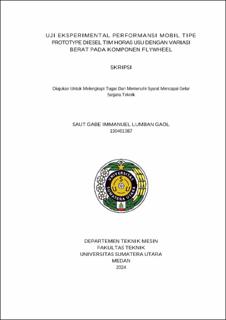| dc.contributor.advisor | Nur, Taufiq Bin | |
| dc.contributor.author | Gaol, Saut Gabe Immanuel Lumban | |
| dc.date.accessioned | 2024-09-02T07:22:05Z | |
| dc.date.available | 2024-09-02T07:22:05Z | |
| dc.date.issued | 2024 | |
| dc.identifier.uri | https://repositori.usu.ac.id/handle/123456789/96531 | |
| dc.description.abstract | Improving vehicle performance is one of the important factors in the development of the modern automotive field. Vehicle performance has a huge impact on the transport sector. Therefore, many countries, especially companies engaged in the automotive sector, are looking for ways to develop vehicles that have the best performance to keep up with the times. One of the efforts made by the Horas USU Team to answer the challenges of developing vehicle efficiency through flywheel components used in the Horas USU Team's Diesel Prototype type car. Flywheel is a solid disc-shaped component that functions to store mechanical energy generated from combustion and then the energy will be forwarded to perform other work steps in the engine combustion system. This study aims to obtain the performance of diesel engines in Prototype Diesel Team Horas USU type cars and the parameters used to determine the performance of Prototype Diesel Team Horas USU type cars are Torque, Brake power, Specific Fuel Consumption, Thermal efficiency, Mean Effective Pressure, and exhaust gas emissions. The highest torque obtained from the dynotest test results was 11.2 Nm at 3100 rpm using a flywheel weighing 2.8 Kg. The highest power brake obtained from the dynotest test was 3.6 kW at 3100 rpm engine speed using a flywheel weighing 2.8 Kg rpm. The lowest specific fuel consumption is found in the engine using a flywheel weighing 4.8 kg which is 183.794 g/kWh at 3000 rpm. The highest thermal efficiency is found in the engine using a flywheel weighing 4.8 kg which is 35.76% at 3000 rpm. The highest mean effective pressure is found in the engine using a flywheel weighing 2.8 kg which is 7.15 Kg/cm2 at 3000 rpm. And the best exhaust gas emissions results are on the engine using a flywheel weighing 4.8 kg. The best results obtained are by using a flywheel weighing 4.8 kg | en_US |
| dc.language.iso | id | en_US |
| dc.publisher | Universitas Sumatera Utara | en_US |
| dc.subject | Flywheel | en_US |
| dc.subject | Performance | en_US |
| dc.subject | Combustion Engine | en_US |
| dc.subject | Exhaust Gaas Emissions | en_US |
| dc.subject | Prototype Diesel Team Horas USU | en_US |
| dc.subject | SDGs | en_US |
| dc.title | Uji Eksperimental Performansi Mobil Tipe Prototype Diesel Tim Horas USU dengan Variasi Berat pada Komponen Flywheel | en_US |
| dc.title.alternative | Experimental Test of Performance of USU Horas Team Diesel Prototype Car with Weight Variation on Flywheel Component | en_US |
| dc.type | Thesis | en_US |
| dc.identifier.nim | NIM190401087 | |
| dc.identifier.nidn | NIDN0018077507 | |
| dc.identifier.kodeprodi | KODEPRODI21201#Teknik Mesin | |
| dc.description.pages | 105 Pages | en_US |
| dc.description.type | Skripsi Sarjana | en_US |


